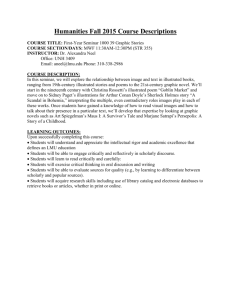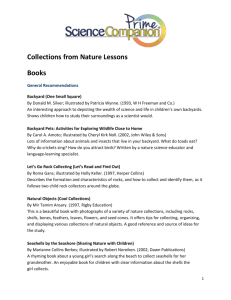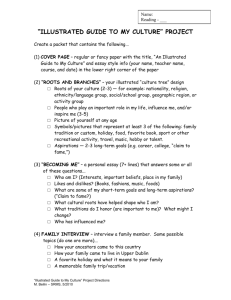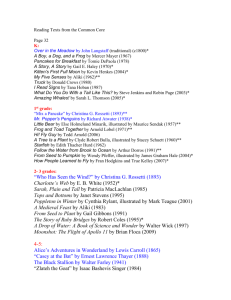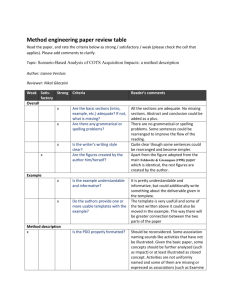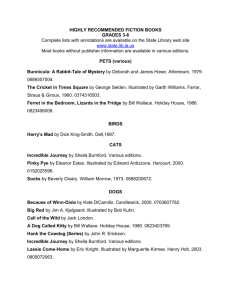A Thematic and Literature-Based Language ... First Grade
advertisement
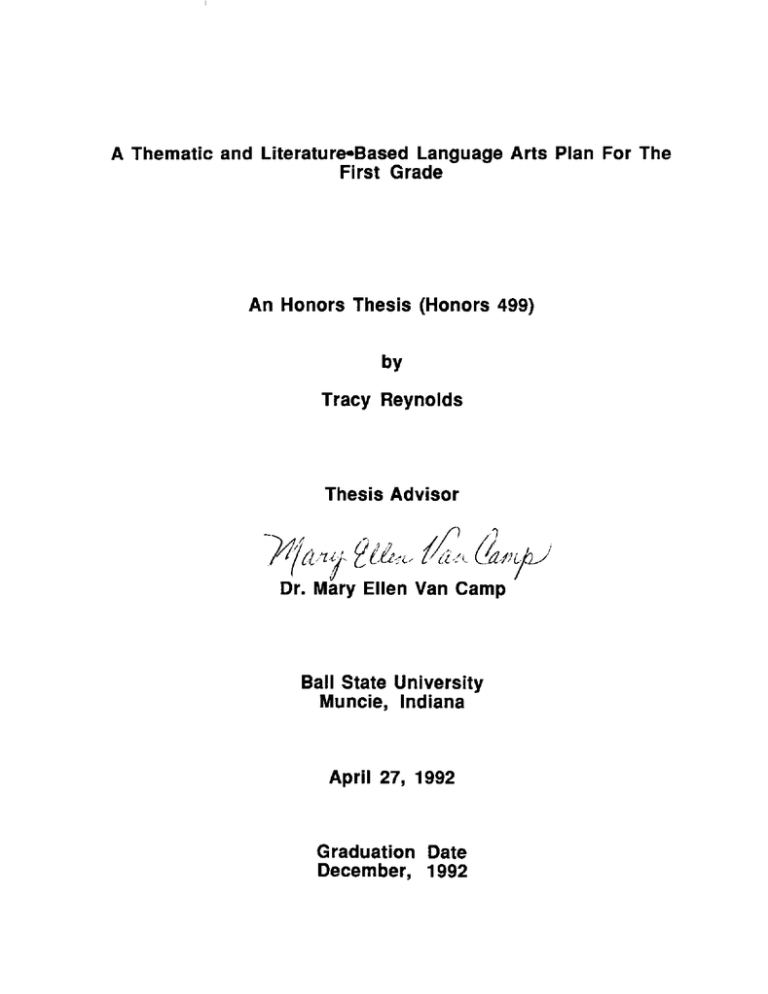
A Thematic and Literature-Based Language Arts Plan For The
First Grade
An Honors Thesis (Honors 499)
by
Tracy Reynolds
Thesis Advisor
Ball State University
Muncie, Indiana
April 27, 1992
Graduation Date
December, 1992
Explanation of the Project
The purpose of this project was to create a thematic and literaturebased plan for teaching the language arts at the first grade level. The
plan that I have written is thematic in that the literature and related
activities focus on various themes, such as dinosaurs, to create increased
interest and motivation for students. It is literature-based in that it utilizes
children's literature to integrate the teaching of the four areas of the
language arts: reading, writing, speaking, and listening.
There are six sections to this language arts plan. The first is a listing
of possible themes a teacher may make use of when planning instruction
for the year. The second section is a statement of year long goals
appropriate for the first grade, and divided into the four branches of the
language arts. The third section is a collection of teacher activities that I
believe are essential to the successful teaching of the language arts using
this plan. Next are listings of possible reading, writing, speaking, and
listening activities which could be employed when preparing lessons.
The fifth section is a group of sample language arts activity plans based
on specific pieces of literature, and on the previously mentioned themes.
Finally, a sixth section, provides a selected bibliography which could
easily be utilized for selecting literature for the first grade classroom.
1. Mystery / Adventure
2. Imagination / Fantasy
3. Animals
A) Insects
B) Endangered Animals
C) Domestic Animals
D) Circus Animals
E) Exotic Animals
F) Under Sea Animals
G) Dinosaurs
4. Our Environment
A) Water
B) Plant Life
C) The Land
D) Weather
E) The Four Seasons
5.
Transportation
A) Boats
B) Planes
C) Cars and Trucks
D) Bicycles
E) Space Transportation
6.
Feelings
A) Fear / Worry / Anxiety
B) Anger
C) Happiness
D) Sadness
E) Anticipation
F) Love
G) Loneliness
H) Isolation From The Group
7.
World Cultures
A) Native American
B) African
C) Russian
D) Asian
F) Hispanic
G) European
H) South American
I) Indian
Reading
• To develop a desire to use leisure time for reading a variety of literature
• To develop the ability to understand and bring meaning to words, phrases, and
sentences
• To develop the ability to use a variety of skills to aid in word recognition and
comprehension (recognition of sound / symbol relationships, visual discrimination,
use of phonetic and structural analysis)
• To develop the ability to determine and expand word meanings through context
clues, synonyms, and antonyms
• To develop print recognition
• To develop the ability to relate background experiences to what is read
• To develop critical and reflective thinking about materials which are read
• To develop the ability to respond actively, imaginatively, and critically to literature
• To develop an understanding of the differences between prose and poetry
Writing
• To develop the use of a process approach to writing (prewriting, writing, revising,
and publishing)
• To develop the ability to write in a variety of forms (stories, poetry, personal
narratives, letters, reports, reviews, jokes, and riddles)
• To develop an understanding of why grammar, punctuation, handwriting, and
spelling are important to good writing
• To develop the ability to use grammar skills when writing (sentence structure, basic
verb tenses, singular and plural nouns, pronouns)
• To develop the ability to use punctuation skills when writing (capitalization, use of
periods, use of question marks, and exclamation points)
• To develop printing skills
• To develop the use of correct spellings in writing situations
• To develop an understanding of a dictionary's importance and use
• To develop the ability to use a picture dictionary
Speaking
• To develop the ability to participate in small group discussions, large group
discussions, and conversations
• To develop the ability to participate in conversations, choral speaking, puppetry,
creative dramatics, joke and riddle telling, storytelling, reporting
• To develop the ability to use speech for a variety of purposes ( to discuss a topic, to
express an opinion, to inform, to question, to entertain)
• To develop comfort in speaking in and to groups
• To develop the ability to successfully use and interpret non-verbal communication
• To develop voice control and articulation when speaking
Listening
• To develop specific knowledge of various types of listening (informative, critical,
appreciative, inferrential, and aesthetic)
• To develop the use of listening for a variety of purposes (for information, for
identifying mood, for separating fact from opinion, for appreciation and enjoyment,
for recognizing propaganda, for evaluation, and for showing courtesy to the
speaker)
• To develop the ability to respond actively, critically, and imaginatively to what is said
~®®@[fl)U~®O
lJ@®©lru@[r
iA\©U~w~U~@®
• Create a nonthreatening environment that allows children to take risks,
and to feel secure.
• Encourage children to do their best.
•
Encourage the envolvement of all students.
•
Provide varied, interesting, and valuable language experiences for the
children.
•
Provide experiences that allow all children to be successful.
• Set realistic expectations for the children.
• Set time aside everyday for the student to read independently.
• Set up a comfortable reading area for the students.
• Maintain a classroom library that includes student and class books,
literature used in class, and high interest books.
• Involve students In selecting books for the classroom library.
• Encourage the students to bring in favorite books to share with the
class.
• Read aloud to the children everyday.
•
Encourage parental partlclapation In the classroom.
•
Provide each child with Individual attention.
• Allow for flexibility in scheduling.
•
Provide varied and Interesting decorations and materials for each
theme.
• Invite speakers to talk to the class on topics that relate to each theme.
•
Plan Integrtaed acitlvltles and experiences around the themes.
• Discuss how each piece of literature read relates to its theme.
• Encourage the students to bring things from home that relate to the
different themes.
• Teach grammar and usage in the context of writing.
• Teach punctuation in the context of writing.
• Encourage children to use proper spellings, and their best handwriting
only when appropriate (publishing experiences).
[F)@®®~[Q)a® ~®®cg]~[fil®
~©u~w~u~®®
• The children will read the other children's stories and poems.
• The children will read the stories and poems that they have written to
small groups.
• The children will listen to literature that is read to them.
• The children will discuss illustration styles in small groups.
• The children will evaluate the illustrations of a specific book, or
several books by the same author.
• The children will participate in the critical analysis of literature in small
or
large groups.
• The children will replace description words in a story or poem with a
synonym or antonym, and analyze how the changes affect the meaning
of the whole piece.
• The class will generate lists of similarities and differences between
prose and poetry as a group.
• The children will, in small groups, choose an unknown word from a
piece of literature, generate ideas as to its meaning from the context,
and come to a consensus as to its meaning.
• The children will generate lists of synonyms and antonyms for words in
small groups.
• The children will discuss and determine, in small groups, the the type
of literature (folk tale, fable, haiku, limerick, etc.) a story or poem is.
• The children will discuss the similarities and differences they find in
stories.
• The children will discuss the similarities and differences in stories by
the same author.
• The children will create a fairy tale mural in which each child
illustrates a favorite fairy tale scene on a large bed sheet or piece of
butcher paper.
• The children will create mobiles or models of a story, or a scene from a
story.
• The children will illustrate what they feel to be the most important
scene in a story.
• The children will Illustrate their own wordless picture books.
• The children will write their own text for wordless picture books.
• The children will create a board game for a story.
• The children will participate in a "favorite character day" for which the
children dress up like their favorite storybook characters, and act as
that character for the day.
[f)@®®~l0a@ \YM[f~U~l1U~
LA\©u~w~u~@®
•
The children will dictate stories individualy, in small groups, or as a
class, which the teacher, or a parent volunteer writes down.
• The children will keep journals in which they share their feelings about
stories or poems that they have read, and life events.
• The children will write their own tall tales, fairy tales, fables, legends,
poems, autobiaographies, non-fiction stories, letters, reviews, jokes,
and riddles.
• The children will brainstorm to generate ideas for their stories.
• The children will make determinations on whether specific pieces of
their writing should be published or not.
• The children will participate in a variety of art activities to stimulate
thinking, and to generate writing ideas.
• The children will create story webs to help them write stories.
• The children will write, and keep lists of, story ideas and starters.
• The children will choose particular pieces of their writing that they
really like, and explain the reasons for their choices.
•
The children will participate in peer editing groups.
• The children will publish their best writing, in the classroom, in a
variety of ways.
Goal
To develop the students' ability to relate background experiences to
literature.
Activity
1. Take the class for a short walk outside the building, and ask the
children to pay close attention to the things that they see during their
walk.
2. When back in the class room the children make lists of the things that
they saw, and write descriptions of those things.
3.
Read the story to the children.
4. Discuss the plot of the story with the children.
5.
Divide the children into groups of four or five, and ask them to discuss
possible connections between what they saw outside, and the
descriptions they wrote, and the story that was read to them.
6. Appoint a member from each group to share the group's Ideas with
the rest of the class.
7. Come to a class consensus about how the walk activity related to the
story Crow~.
~@©©~lPJO@ ®~@®~~l1U®
~©U~W~U~@©
• The children make puppets for a story, and then retell that story using
the puppets.
• The children will be given five to ten minutes of "conversation" time
each morning before starting class.
• The children will act out stories that they have heard.
• The children will participate in readers theater activities using stories
and poems that they have heard.
• The children will participate in choral speaking activities using stories
and poems that they have heard.
• The children will tell their favorite stories to each other in small
groups.
• The children will participate in large group discussions.
• The children will discuss stories, poems, and current events in small
groups.
• The children will take turns giving class announcements.
• The children will give reports over different topics and events to the
class.
• The children will tell jokes and riddles, that they have written
themselves, to small groups.
• The children tell tongue twisters, that they have written or read, to
small groups.
•
The children will be videotaped while participating in various speaking
activities, and then will analyze their own speech.
• The children will read stories, poems, jokes, and riddles, that they
have read or written, onto cassette tape.
• The children will choose pictures from a picture file, and tell stories
about them to small groups.
• The children will tell stories about pictures, that they have created
themselves, to small groups.
[F)@®®~lQ)~@ [b~®u@au~au®
~©u~w~u~@®
• The children will listen to stories that are read to them.
• The children will listen for a predetermined new word and for its
meaning from the context.
• The children will develop class criteria for being good listeners.
• The children will listen to a story, and develop a time line for the plot.
• The children will listen to a story for a specific story characteristic (a
character, the setting, the mood, the main idea, the plot, etc.).
• The children will listen to a story, and generate questions about it to
ask the teacher, or a cooperative group.
• The children will listen to groups of words, and decide which word in
the group does not rhyme.
• The children will listen to groups of words that rhyme and complete the
group with words of their own.
• The children will Identify sounds from a teacher prepared tape of
different sounds.
• The children will listen to groups of words from a story, and identify
which word does not belong in the group.
• The children will develop directions for a specific task, read the
directions to a classmate, and then ask their classmate to follow those
directions.
• The children will listen to a story, and retell that story (using the flannel
board, to a friend, to a stuffed animal or puppet etc.).
• The children will listen to a story and then orally sequence the events
of that story.
• The children will listen to a story, and then choose Important or favorite
parts of that story.
• The children will play repeat and add games in which a child says a
word, the next child repeats the first word and adds a word that fits with
that word, the third child repeats the previous words and adds a word,
and so on.
• The children will listen to stories, and describe or demonstrate the
rhythms that they contain.
• The children will listen to a story or to music, and respond with
movement or pantomime.
• The children will listen to stories the teacher tells to them.
• The children will listen to stories which have been read onto cassette
tape, and follow the story in the book.
~©unwnun@© ~@O®u@@]
lJ@
®[.Q)@©niJn© [F)n@©@© @iJ
[bnu@~®u[!J] ~@
Goals
To compare and contrast two similar books by the same author.
To introduce the students to the works of Mercer Mayer.
Activity
1. Read the books to the students.
2. Divide the children into six groups.
3. Assign two groups to each of the topics (similarities and differences in
the Illustrations, similarities and differences in the plots, and
similarities and differences in the characters).
4. Ask each group to come up with a list of examples and thoughts on
their topic from the two groups
5. Ask a representative from each group to share their group's list with
the rest of the class.
6. Point out other books by Mercer Mayer to the class that they might
want to read.
&Ull@ If@ IfDlloUll[k< IfDll@U Jl ®@W18
®U[J@@U
U©
Ull [MJ(l,I]~@@[J[J)'i
Goal
To develop pre-writing skills.
Activity
1. The afternoon before you read the story to the class ask the children to
pay close attention to what happens as they go home from school.
2. The next day ask the students to make a list of the things that
happened, and that they saw as they went home from school the
previous day.
3. Read the story to the children.
4. Discuss with the children how their lists differ from what happened to
the little boy in the story on his way from school.
5. Ask the children to use their Imaginations to change their lists so that
they are more interesting and exciting.
6. The children dictate or write And To Think That I Saw It On
Street stories.
7. The children illustrate their stories.
JLnOO©l[iH
lbJ)j
c~u~~ V©lUll fo\~~~lbJLn[l'@
Goal
To develop ttle students' Interest In reading.
Activity
1. Read the story to the students.
2. Divide the students Into groups of four or five.
3. The students create their own jungle games in small groups.
4. The groups exchange the games.
5. Each group plays another group's game.
Goal
To develop the students' concept of a story line.
Activity
1. Children individually, and at different times, write the story line for this
wordless picture book.
2. Divide the children Into groups of four.
3. The children compare the different story lines of the group members.
Goal
To develop the students' letter writing skills.
Activity
1. About a week before this story is read ask the students to bring in a
stamp from home.
2. Read the story to the students.
3. Discuss the characters, and those characters' feelings with the
students.
4. Discuss letter writing with the students.
5. The students write letters to one of their family members, describing
their feelings toward them.
6. Help the students address envelops for their letters.
7. Send the students' letters.
Goal
To help the students make connections between their lives and literature.
Activity
1. Read the story to the students.
2. Discuss with the children the feelings of happiness and sadness, and
how they relate to this story.
3. Children write What Makes Me Happy, and What Makes Me Sad
lists.
4. Divide the students Into groups of 4.
5. The children share their lists with their groups.
~~ [F @ [1' ~ lID ~
hITiTIl @
@
~ ~
U lID ~ @ (Q) [F
~ [Pl @ @@ ~ @ [1'9
[M] @ [jj) lk\@ Sf ~ ~ [jj) @ U [ru @ 0[1' [M] @ [jj) lk\ @ Sf
lID IlJl ~ 0[jj) @ ®~
Goal
To develop the students' concept of main Idea.
Activity
1. Discuss main Idea with the students.
2. Read the story to the students.
3. Discuss the main Idea of the story with the students.
4. The children draw a picture of what they feel to be the most important
part of the story.
5. Divide the children Into groups of four.
6. The children describe to their group how the scenes that they drew
relate to the main idea of the story.
4&O@)X\ID[fi)(QJ@1J' £@@jl[}j)@ u®[lJ'oIWO@~ []]@IT'lJ'oIWO®a
[N] @ @@@iQL 'Sf® IT'N ® ®©l [Q) ® ~
Goal
To use literature to help children explore their own feelings.
Activity
1. Discuss "bad days" with the children, and how those days make
people feel.
2. Read the story to the children.
3.
Discuss the events of Alexander's day, and his feelings during his
"horrible" day with the children.
4. The children write in their Journals about a bad day that they had, the
feelings that they had during that day, and how their feelings related
to those of Alexander's.
5.
The children create "how I feel today" collages.
Goal
To develop the students' knowledge of a fable.
Activity
1.
Explain to the children what makes a story a fable.
2. Tell the children that they are going to listen to a fable, and ask the
children to listen for the elements of a fable while they listen to the
story.
3.
Read the story to the children.
4.
Discuss the plot of the story with the children.
5.
Ask several students to describe what they learned from the story.
6.
Review with the children the elements that make a story a fable.
7.
Divide the class into groups of three or four, and give each group the
task of deciding what happens in the story that makes it a fable.
8.
Appoint one child in each group as group leader, and ask each group
leader to explain their group's answer to the rest of the class.
9. Come to a class consensus as to why Alexander And The Wind:..!.!..9.
Mouse is a fable.
Goal
To develop the students' ability to relate background experiences to
literature.
Activity
1. Take the class for a short walk outside the building, and ask the
children to pay close attention to the things that they see during their
walk.
2. When back in the class room the children make lists of the things that
they saw, and write descriptions of those things.
3.
Read the story to the children.
4.
Discuss the plot of the story with the children.
5.
Divide the children into groups of four or five, and ask them to discuss
possible connections between what they saw outside, and the
descriptions they wrote, and the story that was read to them.
6.
Appoint a member from each group to share the group's ideas with
the rest of the class.
7. Come to a class consensus about how the walk activity related to the
story Crow~.
ill
[Q)@@!$l [N]@U
®@ ~
ffi0Il@@\Wl ~
~ Oll @l (Q) U [fu @ IT' ~ Oll 0 IJ1]j) ® ~ ~ [fu
11 IJ1]j) @ !$l
Goal
To develop the students' knowledge of riddles, and their writing skills.
Activity
1.
Discuss with the children what a riddle Is.
2. Read the riddle book to the children, allowing the children to try to
answer the riddles.
3.
Ask the children to describe what they like about riddles.
4.
Share two or three animal riddles that you have written with the
students, and let them guess the answers.
5.
The children individually write three animal riddles.
6.
Divide the children Into groups of four, and have the children read
their riddles in small groups.
7.
Each student decides which of their riddles he or she likes the best,
and those riddles are checked for spelling and grammar errors by the
other members of the group.
8.
The children draw pictures of the animals that their riddles are about.
9.
The students recopy their riddles onto their pictures.
10.
The riddles are posted around the room.
Goal
To develop the students' sequencing skills and small group discussion
skills.
Activity
1. Tell the story to the children using the flannel board.
2.
Discuss the events of the plot In order of occurrence with the children.
3. Divide the students Into five or six groups.
4. Each group makes a set up puppets for the story. and decides on
which child will be each character when the story is retold.
5.
The children retell the story using their puppets in their small groups.
Goal
To develop the students' appreciation of literature.
Activity
1. Select two of the stories from the book, and read them to the students.
2. Divide the students Into groups of four or five.
3. Each group member shares with the group which of the stories he or
she liked best, and why.
4.
5.
Individually, the students choose their favorite scene from one of the
stories, draw a picture of that scene, and write a short description of
what Is going on in that scene for their pictures.
Display the pictures around the room.
Goal
To develop the students' knowledge of non-fiction books, and their
handwriting skills.
Activity
1. Discuss what non-fiction is with the students.
2. Tell the students that the book they are about to hear is a non-fiction
book.
3.
Read the book to the children.
4. Discuss why the book is non-fiction with the class.
5.
Discuss the importance of feet with the class.
6.
Have each child make a list of important things that their feet do.
7.
Have the children recopy their lists onto their construction paper feet
using their best handwriting.
8.
Display the children's feet around the room.
U[l'®ITilITil@®®Il1l[l'Il1l® W®®
Ik
[ID@®®U~
[Q)OITil@®®Il1l[l'
~@@IJi]j)®
Goal
To develop the students' knowledge of poetry.
Activity
1. Discuss what a poem is with the students.
2.
Discuss the differences between poetry and prose with the students.
3.
Read the book to the children.
4.
Discuss selected poems with the students.
5. Write a dinosaur poem as a class.
6.
Write the poem on a large construction paper dinosaur.
7. Read the poem out loud to the class.
8.
Read the poem out loud as a whole class.
W Gil \'f 1M] @ ~ CQ] OJ] 0U@ ® ~ @ OJ] ~ ~ ~ [)l) IF! ® @ [gJ ~ ® ~~
W®~U &Oil[l'O@iID[)l) lJiID ~ ®
~ iID [l' ® ~
&0
Goal
To develop the students' understanding of the importance of illustrations
to a story.
Activity
1. Read the story to the children, and ask the students to pay careful
attention to the illustrations.
2. Discuss the plot of the story with the children.
3.
Discuss with the children why the Illustrations are important, and
improve the story.
4.
Ask the students to point out particular Illustrations that they like, why
they like them, and how the Illustrations depict what is going on in
the story.
5. Have the children write In their journals about what they liked about
the artwork In Why Mosqyltoes Byzz in People's.Esilli.
iJ[lj]® [b@~®[jj]@l
© lP
iJ [lj] ® ~ @~ ® [jj] @
iJ[lj]® ~~llil®[Q)@[jj][jj]®U~
iJlID~® ©~ iJ®2:'{lID®
©
~[jj] ©~@
~ iJ [lj] ® ~ [jj] @ 0lID [jj] ~ lID 0 [jj] U[Q) IT' llil ® [lj]
[Q)W
Goal
To introduce the students to the work of Tomie de Paola.
Activity
1. Read both stories to the students.
2. Discuss the plots of both stories with the students.
3. Discuss the artwork of the two books with the students
4.
Divide the students into groups of four or five, give each group a copy
of the two books, and ask the students to analyze the similarities and
differences in the two books by the same author. Advise the groups
to look at both the plot and the illustrations. Ask one member of
each group to keep a record of the ideas presented in the group.
5. Ask one member of each group to share the group's findings with the
rest of the class.
Goal
To improve the students' creative writing, and reading skills.
Activity
1.
Schedule parent volunteers for the class if possible
2. Read the story to the students.
3. Discuss the plot of the story with the students.
4. Ask the children to think about why they think the sun comes up at the
beginning of the day, and goes down at the end of the day.
5.
Have the children dictate stories about the sun to the teacher or a
parent volunteer.
6.
Ask the children to illustrate their stories.
7.
Put the children's stories in book form.
8.
Have the children read their stories to each other in small groups.
[Q)w
JJ®mm@~
lI¥1l®[f~[h)®~~
Goal
To develop the students' understanding of the similarities and
differences In two versions of the same story.
Activity
1. Read I..!:!.§ Three Little f.i..Wi to the students.
2.
Discuss the plot with the students.
3.
Read Ila Ir.u.e. Story Qf I..!:!.§ Three Little El.Q..s to the students.
4.
Discuss the plot with the students.
5.
Discuss the fact that there are sometimes two or more versions of the
same story written, and that there are similarities and differences
between those versions.
6. Divide the students Into groups of four or five.
7.
Have each group answer the questions: What Is the same about the
two stories?, What is different about the two stories?, Which of the
two stories do you like best?, and Why?
8.
Ask one member of each group to share their group's answers with
the rest of the class.
Goal
To improve students' speaking skills.
Activity
1. Read the story to the children.
2.
Discuss the plot and the characters with the children.
3.
Divide the students into groups of four.
4. Tell the students that they are going to act out the story in their
groups.
5.
Have each group determine who will be each character in the story.
6. Allow time for the groups to practice acting out the story.
7. Have each group act out the story for the rest of the class.
Goal
To develop the students' knowledge of what a character is.
Activity
1.
Discuss with the children what a character Is.
2. Read the story to the children, and ask them to pay careful attention to
the characters in the story.
3.
4.
Discuss the characters In the story with the children.
Have the children to choose a character from the story, and write a
description of that character.
5.
Have the children to draw a picture of that character.
6.
Have the children recopy their character description onto another
piece of paper.
7.
Attach the students' character descriptions to their pictures, and
display them around the room.
Goal
To develop the students' concept of a story line.
Activity
1. Explain to the students that sometimes a story is told without any
words, only pictures, and that to understand the story you must pay
close attention to the pictures.
2.
Have the students Individually read The Snowman, and write the story
that they feel goes with the pictures.
3. Divide the class into groups of four or five, and ask the students to
share their stories with the other members of their group.
4.
Discuss the differences among the story's interpretations, and that
that Is all right because there is no right or wrong interpretation.
Goal
To develop the students' ability to see the relationships between a
fictional story and a real life situation.
Activity
1.
Review information about the environment with the students ..
2. Read the story to the children, and ask them to think about the
environment while the story is being read.
3.
Discuss the plot of the story with the children.
4. Discuss what happens to the environment in the story with the
children.
5.
Discuss the parallel between the environment in the story. and the
environment of our planet.
6.
Have each child plant a seed in the classroom, and when it is big
enough send the plant home with the students to plant at home.
Goal
To Improve the students' listening skills.
Activity
1. Tell the students that they are going on a listening walk, and explain
to the students that during this walk they are to listen carefully to the
things that are going on around them. Tell the students that when
they come back from their walk they will be writing about what they
heard.
2. Take the class on a listening walk outside.
3. When you get back ask the students to make a list of all the things
that they heard, and what made those sounds.
4. Read the story with the students.
5.
Discuss the similarities and differences in what the students heard on
their walk, and what was heard during the walk in the story.
Goal
To Improve the students' concept of a story line.
Activity
1.
Review the Idea of the wordless picture book.
2.
Show the students the students the story as a class.
3. Discuss the plot of the story
4.
Have the students illustrate their own wordless picture books that
have a definite story line.
5. Divide the students Into groups of four or five, and have the students
share their books with their group.
Imagination / Fantasy
Adoff, Arnold. OUTside INside Poems. Illustrated by John Steptoe. New
York: Lothrop, Lee and Shepard Books, 1981.
Brown, Marcia. Stone Soup. An
Sons, 1947.
fu.
Cameron, John.
If Mice Could
Crews, Donald.
Ten Black.!22.t.s..
dePaola, Tomie.
1985.
Q.!Q~.
New York: C. Scribner's
New York:
New York:
Atheneum, 1979.
Greenwillow Books, 1986.
Tomle dePaola's Mother Goose. New York: Putnam,
Galdone, Paul. The Monkey And The Crocodile: A Jataka Tale From
India. New York: Seabury Press, 1969.
Moon Mouse. Illustrated by Cyndy Szekeres. New York:
HolI, Adelaide.
Random House, 1969.
Keats, Ezra, Jack. Regards
Winds Press, 1981.
12.~
Kuskin, Karla. .A.rul. ~! Want
and Row, 1972.
Kuskin, Karla. Square
Man Qn The Moon. New York: Four
12. ~ ~ Poems. New York: Harper
AJi A House. New York: Harper, 1960.
Levenson, Dorothy. ~ Maaic Carousel. Illustrated by Ati Forberg.
New York: Parent's Magazine Press, 1967.
Lionnl, Leo. Alexander An.d I.U Wlnd:.ll.R Mouse. New York:
Pantheon Books, 1969.
Lionnl, Leo.
Cornelius l A Fable. New York:
Lionni, Leo.
Frederick. New York:
Lobel, Anita.
I.h.i Straw Maid. New York: Greenwillow Books, 1983.
Lobel, Anita.
I.h.i:rutll Music. New York: Harper and Row, 1966.
Lobel, Arnold.
Fables. New York:
Pantheon Books,
Pantheon Books,
1983.
1967.
Harper and Row, 1980.
Mayer, Mercer. Bubble Bubble. Bew York:
Four Winds Press,
Mayer, Mercer. There's An Alligator Under My.6.e..d.. New York:
Books For Young Readers, 1987.
Mayer, Mercer. There's A Nlghtmare!.n My Closet. New York:
Press, 1968.
Mayer, Mercer. What.l2..2.Ysut..12..2 W!1h A Kangaroo?
Four Winds Press, 1973.
1973.
Dial
Dial
New York:
Mayer, Mercer. Whlnnle I.h.i Lovesick Dragon. Illustrated by Diane
Dawson Hearn. London: Collier Macmillan, 1986.
Sendak, Maurice.
I.h.i ~ Qn Rosie's Door. New York: Harper, 1960.
Sendak, Maurice.
Row, 1963.
Where I.h.i WlJ.d. Things Are. New York:
Harper and
Seuss, Dr. AnA I2. Think IhAll SJl.w 11 Qn Mulberry Street. New York:
The Vanguard Press, 1937.
Seuss, Dr. Ih.i k.IU l.n Ih.i .!::!At. New York: The New Vanguard Press,
1937.
Seuss, Dr. ill B.iln ~ l..Q..Q.. New York:
Random House, 1950.
Shecter, Ben. Conrad's Castle. New York:
Harper and Row, 1967.
Silverstein, Shel.
1981.
A Light l.n ~~. New York: Harper and Row,
Silverstein, Shel.
Drawings
1974.
Where
~
Sidewalk Ends:
New York:
mSlal Silyerstein.
Poems D..rut
Harper and Row,
~
Steig, William. Sylyester And. ~ Magic pebble. New York:
Books, 1969.
Thurber, James. Many Moons. Illustrated by Louis Siobodkin.
York: Harcourt, Brace and Company, 1943.
Uchida, Yoshiko.
Am Qt Dreams.
Uchida, Yoshiko. The Magic
1955.
Van Allsburg, Chris.
1981.
New York:
Listenlng~.
Windmill
New
Antheneum, 1982.
New York:
Harcourt, Brace,
Jumanll. Boston: Houghton and Mifflin Co.,
Wiesner, David. fLu.Eall. New York:
Books, 1988.
Lothrop, Lee and Shepard
Worth, Valerio. Small Poems. lIustrated by Natalie Babbitt. New York:
Farrar, Straus and Giroux, 1972.
Wyndam, Robert. Chinese Mother Goose Rhymes. Cleveland:
Pub. Co. , 1968.
World
Yorinks, Arthur. ~ AI. Illustrated by Richard Egielski. New York:
Farrar, Straus and Giroux, 1986.
Feelings
Anderson, Hans Christian. princess Arul I.h.l.P.u. Illustrated by Paul
Galdone. New York: Seabury Press, 1976.
Carle, Eric. I.h.l Grouchy Ladybug. New York: T. Y. Crowell Co., 1977.
Carle, Eric. I.h.l Mixed-Up Chameleon. New York:
Cohen, Miriam, and Lillian Hoban.
Macmillan, 1967.
Crowell, 1975.
.wm 1 Have A Friend?
New York:
Hltte, Kathryn. ~ WU 1 Mad!. Illustrated by Mercer Mayer. New York:
Parents' Magazine Press, 1969.
Keats, Ezra Jack.
A Leuter I2. Amy. New York:
Keats, Ezra Jack.
peter's Chair. New York:
Keats, Ezra Jack.
Whlstle.E2..!: Willie. New York:
Kellog, Steven.
Harper and Row, 1966.
Harper and Row, 1967.
pinkerton. Behaye!. New York:
Viking Press, 1964.
Dial Press, 1979.
Kuskin, Karla. Herbert Hated Being Small. Boston: Houghton
Mifflin, 1979.
Seuss, Dr. I.h.l Butter Battle Book. New York:
Silverstein, Shel.
Random House, 1984.
IM Glvlng~. New York: Harper and Row, 1964.
Siobodklna, Esphyr. Caps W Sale: A IiI.1.§. Q1 A peddler, Some
Monkeys i!.ru1 Their Monkey BUSiness. New York: W. R. Scott,
1947.
Viorst, Judith. Alexander AruI IhI Terrible. Horrible .
.fig, Good. YI.rx 11U.I2Jul. Illustrated by Ray Cruz.
Atheneum, 1972.
Waber, Bernard. Ih!.t Names Wl!.! Never .I::!..!.!.tl~.
Mifflin, 1976.
Waber, Bernard. lr..Il Sleeps 2.ll.H.
Boston:
Yashima, Taro. Crow 1tQx. New York:
New York:
Boston:
Houghton
Houghton Mifflin, 1972.
Puffin Books, 1983.
Zemach, Margot. it Could Always fa Worse: A Yiddish Folk !ill.
New York: Farrar, Strauss and Giroux, 1976.
Zolotow, Charlotte. I.h.l Hating Book.
York: Harper and Row, 1968.
Illustrated by Ben Shecter. New
Animals
Armour, Richard Willard. A Dozen Dinosaurs. Illustrated by Paul
Galdone. New York: McGraw-Hili, 1967.
Bauer, Margaret Jean. Animal Babies. Illustrated by Jacob Bates Abbot.
Northbrook: Hubb3rd Press, 1972.
Carle, Eric.
Animals. Animals.
New York:
Philomel Books, 1989.
Carle, Eric. The Very. Hungry Caterpillar. New York:
1987.
Philomel Books,
Davis, Reda. Martin's Qinosaur. Illustrated by Louis Siobodkin. New
York: Crowell, 1959.
s.u
De Regniers, Beatrice Schenk. 11 Does !fQ1
Meow: And Other animal Riddle Rhymes. Illustrated by Paul
Galdone. New York: Seabury Press, 1972.
Donnelly, Liza.
Gag, Wanda.
Galdone, Paul.
Djll.<LSjllli Garden.
MilliQD.§:. Of Qats.
New York:
New York:
The Uttk Red Hen.
Scholastic Inc., 1990.
Coward-McCann, 1928.
New York:
Seabury Press, 1973.
Hewett, Joan. W::tch ing Them Grow: Inside A Z.Q.Q.
Nursery. III;.;strat;:d by Richard Hewett. Boston: Little, Brown,
1979.
Hopkins, Lee Bennet. Dinosaurs: Poems. Illustrated by Murray
Tinkelman. San Diego: Harcourt Brace Jovanovich, 1987.
I.h.I Mysterious Tadpole. New York: Dial Press, 1977.
Kellog, Steven.
m.
Lobel, Arnold. I.h.I Book
plgerlcks: f.!.g Limericks. New York:
Harper and row, 1983.
Lobel, Arnold.
Low, Joseph.
Whiskers
il..rut Rhymes. Greenwillow Books, 1985.
MU<Jl Twice. New York: Atheneum, 1981.
McCloskey, Robert. Make WU f..Qr pucklings. New York:
The Viking Press, 1941.
McDearmon, Kay. Foxes. New York:
Dodd, Mead, 1981.
McGowen, Tom. Album Qt plnosaurs.
Rand McNally, 1972.
Illustrated by Rod Ruth.
Machotka, Hana.
1991.
What
N.u1 Feet!.
New York:
Mayer, Mercer. A Il2x.. A J2iUL. A Frog. A.nsI A
Friend. Illustrated by Marianna Mayer.
1971.
Milne, A. A.. I.h.I World Qt Pooh.
York: DuHon, 1957.
Morris,Robert A.. Seahorse.
Harper and Row, 1972.
Parish, Peggy. Dinosaur Time.
Harper and Row, 1974.
Chicago:
Morrow Junior Books,
New York:
Dial Press,
Illustrated by E.H. Shepard.
Illustrated by Arnold Lobel.
Illustrated by Arnold Lobel.
New
New York:
New York:
Mystery and Adventure
Aesop. Twelve Tales From Aesop. Retold and Illustrated by Eric Carle.
New York: Philomel Books, 1980.
Ambrus, Victor G.. The Valient Little Tailor. Oxford and New York:
Oxford University Press, 1980.
Asbiornsen, Peter Christen. The Three .!li!.!Y Goats Gruff. Illustrated by
Paul Galdone. New York: Seabury Press, 1973.
Bonsall, Crosby Newell. The Case Of The Cat's Meow. New York:
Harper and Row, 1965.
Burton, Virginia Lee. Mike Mulligan i!ill!. His Steam Shovel. Boston:
Houghton Mifflin Company, 1939.
Crews, Donald.
Carousel.
New York:
Galdone, Paul.
Little.B.§.d. Riding Hood.
Grimm, Jacob. Tales From Grimm.
1936.
Harris, Joel Chandler.
Brothers, 1941.
Greenwillow Books, 1982.
New York:
New York:
McGraw-Hili, 1974.
Coward-McCann, inc.,
Brer Rabbit. New York and London: Harper and
Kraus, Robert, Bruce Kraus. The Dectective 21 London. Illustrated by
Robert Byrd. New York: Windmill Books, 1977.
Marshall, James. Golilocks And The Three Bears. New York:
Dial Books For Young Readers, 1988.
Politi, Leo. When Butterflies Come. New York:
Scribner, 1957.
Prelutsky, Jack. Tyrannosaurus Wiui A Beast:
Dinosaur poems. Illustrated by Arnold Lobel.
Greenwlllow Books, 1988.
New York;
Sackett, Elisabeth, and Martin Camm. Illustrated by Cynthia Overbeck
.alL Danger Qn I..!l.I Arctic kt. San Francisco: Sierra Club Books,
1991.
Selsam, Millicent. Benny's Animals. A.rul.l::l.2Yt.!::!...i
.P.W Them In Order. Illustrated by Arnold Lobel.
and Row, 1966.
New York:
Harper
Wolkensteln,Dlane. I..!l.I Banza ~ A Hatlan Story. Illustrated by Marc
Brown. New York: Dial Press, 1981.
Marshall, James. B..!uI Riding Hood. New York:
Young Readers, 1987.
Marshall, James. I.I:!..i Three Little
Young Readers, 1989.
~
Dial Books For
New York:
Dial Books For
Perrault, Charles. Cinderella. Illustrated by Susan Jeffers.
Dial Books For Yound Readers, 1985.
New York:
Potter, Beatrix. Ih.i. IiIl.i Qf peter Rabbit. Illustrated by David
Jorgensen. Saxonv!lle: Rabbit Ears Books, 1988.
Scieska, Jon. I.h.I. I.!:.wt Story Qf I.I:!..i Three Little~.
Lane Smith. New York: Viking, 1989.
Illustrated by
World Cultures
Aardema, Verna. Bringing I.h.i B.Iln IQ. Kapitj plain ~ A Nandi~.
Illustrated by Beatrlz Vidal.
New York: Scholastic, 1981.
Aardema, Verna.
w.b.x Mosqujtoes Buzz In people's ~.;. A West
African~.
York:
Illustrated by Leo Dillon, and Diane Dillon.
Dial Press, 1975.
Baylor, Byrd. .And. 11 ~ S1ll.I IhA1 YhY..;. Leaends.
Scribner, 1976.
New
New York:
Bernstein, Margery, and Janet Kobrin. Coyote Goes Hunting E.2r f.i..r§..
Illustrated by Ed Heffernan.
New York: Scribner, 1974.
Carpenter, Frances. Tales Q1 A Korean Grandmother.
Doubleday, 1947.
Garden City:
Carpenter, Frances. Tales Q1 A Russian Grandmother. Illustrated by
I. Blllbine. Garden City: Doubleday, Doran, and Company, Inc.,
1933.
Clark, Ann Nolan. Along Sandy Trails. Illustrated by Alfred A. Cohn.
New York: Viking Press, 1969.
1M.s..u.n
Dayrell, Elphlnstone. w.b.x
An.d. The Moon .I.J..ll.§.!.n I.h.i lli.
Boston: Illustrated by Blair Lent. Houghton Mifflin, 1986.
de Paola, Tomle. I.h§. Legend Q1 I.h§. Bluebonnet.;. An QUI Ta..L.e Q1
Texas. New York: Putnam, 1983.
de Paola, Tomle. I.h§. Legend Q1 I.h§.lridjan pajntbrush.
Putnam, 1988.
New York:
de Paola. Tomle. ~ Mysterious Giant Qf Barletta.i An Italian
Folktale. San Diego: Harcourt Brace Jovanovich. 1984.
de Paola. Tomle. Strega Nona: An
1975.
Q.llI~.
New York:
Scholastic.
Farguhar. Margaret C.. Indian Children Qf America. Illustrated by
Brinton Turkle. New York: Holt. Rinehart and Winston. 1964.
Gobel. Paul.
1980.
~
G!tt Q! ~ Sacred.D..Q.a.. Scarsdale: Bradbury Press.
Gobel. Paul. ~ ~ W!!.2 Loved
Press. 1978.
Gobel. Paul.
Haley. Gall E.
sar 1l2ll.
W!!.d. Horses. Scarsdale: Bradbury
Scarsdale:
Bradbury Press. 1983.
A Story, A Story. New York: Atheneum. 1970.
McDermott. Gerald. Anansj The Spider. New York:
Winston. 1972.
Holt. Rinehart and
Marmur. Mildred. Japanese Fairy Tales. New York:
Golden Press. 1960.
Wyndham. Robert. Chinese Mother Goose Rhymes.
Pub. Co .• 1968.
Cleveland:
World
Our Environment
Bancroft, Henrietta. Down Come :r!:Ut Leaves. Illustrated by Nonny
Hogrogian. New York: Crowell, 1961.
Briggs, Raymond. :r!:Ut Snowman.
Burton, Virginia Lee.
Mifflin, 1971.
Fox, Charles Philip.
Co., 1962.
K.i!tY And
New York:
Random House, 1978.
The Big Snow. Boston: Houghton
When Winter Comes. Chicago: Reilly and Lee
Hall, Donald. Qx:. ~ MM. Illustrated by Barbara Cooney. New York:
Viking Press, 1979.
Jacobs, Leland B.. Poetry .E2r Winter. Illustrated by Kelly Oechsli.
Chanpaign: Garrard Publishing Co., 1969.
Hopkins, Lee Bennett. :r!:Ut s.k.Y. Is. E.!.!..!.l Q! Song. Illustrated by Dirk
Zimmer. New York: Harper and Row, 1983.
Keats, Ezra Jack.
~
Snowy Q.sly.
New York:
Viking Press, 1962.
Kessler, Ethel. AII.E2r Fall. Illustrated by Leonard Kessler.
Parents' Magazine Press, 1974.
New York:
Kuskin, Karla. in. The Flaky Frosty Morning. New York: Harper and
Row, 1969.
Lobel, Anita.
Alison's Zinnia. New York:
Loretan, Sylvia. 8.2..tl I.h§. Snowman.
New York: Viking, 1991.
Greenwillow Books, 1990.
Illustrated by Jan Lenica.
McCloskey, Robert. Blueberries.E.!il SJt!. New York:
McCloskey, Robert. Time Q1 Wonder. New York:
Viking Press, 1948.
Viking Press, 1957.
McKissack, Pat, and Patricia C. McKissack. Mirandv And Brother Wind.
Illustrated by Jerry Pinkney. New York: Knopf, 1988.
Selsam, Millicent Ellis, and Joyce Hunt. A .E1.W Look At Insects.
Illustrated by Harriett Springer. New York: Walker, 1974.
Seuss, Dr. I.h§. Lorax. New York:
Showers, Paul.
Random House, 1971.
The Listening Walk.
New York:
Tresselt, Alvin R. White Snow. Bright Snow.
Lee and Shepard Co., 1947.
Udry, Janice May. A
Ir..!t!l Ui~.
Zolotow, Charlotte. Summer Ui:.:..
York: Crowell, 1967.
New York:
Crowell, 1961.
New York:
Lothrop,
Harper, 1956.
Illustrated by Ruth Lercher. New
Zolotow, Charlotte. ~ Summer Night.
York: Harper and ROW, 1974.
Illustrated by Ben Shecter.
New
Transportation
Barton, Byron. Airport. New York: T. Y. Crowell Junior Books, 1982.
Cole, Joanna. .c..ns. A.ruI.I::!.iU! They.G..Q.
New York: Crowell, 1983.
Crews, Donald.
Freight Rain.
Crews, Donald.
Truck.
Gibbons, Gail.
Illustrated by Gail Gibbons.
New York:
New York:
Greenwillow Books, 1978.
Greenwlllow Books, 1980.
.tk.Yt Road!, New York: T. Y. Crowell, 1983.
Gibbons, Gail. Rains. New York:
Let's Dlscoyer Flying.
2nd ed.
Holiday House, 1987.
Milwaukee:
Peet, Bill. The Caboose Who QQ1 Loose.
1971.
Raintree Publishers, 1986.
Boston:
Houghton Mifflin Co.,
Piper, Watty. IM Little Engine I..Il.Ilt Could. Illustrated by Ruth
Sanderson. New York: Platt and Munk, 1976.
Sattler, Helen Roney. Rajn Whjsles: A Language In Code.
Lothrop, Lee and Shepard Books, 1985.
Zaffo, George J. IM IlliI Book Q! ~ Boats And Ships.
Grosset and Dunlap, 1951.
New York:
New York:
Department of Education's Language Arts and Foreign Language Unit.
Handbook f..Qr Planning An Effective Literature Program
Kindergarten Through Grade Twelve. Sacramento: California
State Department of Education, 1987.
Department of Education's Language Arts and Foreign Language Unit.
Recomended Readings In Literature Kindergarten Through Grade
Eight. Sacramento: California State Department of Education,
1986.
English-Language Arts Curriculum Framework and Criteria Committee.
English-Language Am Framework f..Qr California Public Schools
Kindergarten Through Grade Twelve. Sacramento: California
State Department of Education, 1987.
Ohio Department of Education. Elemenatry Language ~,;, Strategies
f..Qr Teaching Awl Learning. Columbus: Ohio Department of
Education, 1982.
Pappas, Christine C., Barbara Z. Kiefer, and Linda S. Levstik. An
Integrated Language Perspective In I.h.l Elementary School,;,
Theory J.n.1.Q. Action. New York: Longman, 1990.
Petty, Walter T., Dorothy C. Petty, and Richard Salzer. Experiences In
Language,;, Tools Awl Techniques f..Qr Language ~ Methods.
5th ed. Boston: Allyn and Bacon, 1989.
Watson, Dorothy J., ed. Ideas Awl Insights ,;, Language ~ In The
Elementary School. Urbana: National Council of Teachers of
English, 1987.

